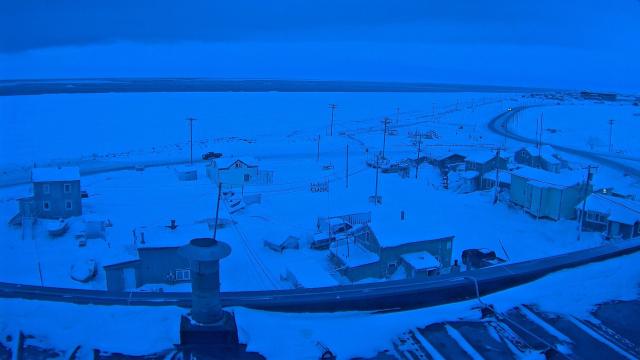Something strange is happening to the northernmost city in the United States. It’s the dead of winter, and temperatures in Utqiaġvik (formerly Barrow) should be well below zero. Late last week, they soared into the 20s and 30s—practically beach weather for Arctic Alaska.
On February 7, temperatures in Utqiaġvik flirted with the freezing mark, possibly setting a new daily high record as the normally-solid wintertime sea ice offshore gave way to open water.
The heat wave wasn’t isolated—the entire North Slope of Alaska was running a fever -1 to 10 degrees Celsius above normal. Meanwhile, to the south, levels of ice in the Bering sea were plummeting. Since January 25, Bering sea ice has receded 35 per cent, according to Rick Thoman, a climate scientist with the Alaska Center for Climate Assessment and Policy.
All of this, Thoman says, is related to a series of storms that moved from the North Pacific into the central and western Bering starting in late January. Some of those storms continued north into the Chukchi sea as well, and in doing so “transported very warm air up to the North Slope,” Thoman told Earther. The heat wave backed off this week, with temperatures dropping back into bone-rattlingly cold (aka normal) territory, although the respite from could be short-lived.
Either way, the sudden midwinter thaw falls in line with an pattern of heat and icy woes for northern Alaska, reminding us that the region continues to be ground zero for the impacts of climate change. Data Thoman shared with Earther shows Februarys in Utqiaġvik have warmed a staggering 11 degrees Celsius over the past 50 years — the highest jump of any month, although autumns on the North Slope are also seeing very rapid warming, which helps explain why the sea ice that forms offshore as the sunlight wanes has been weak as hell lately.
That the sea ice was already in a weakened state this year almost certainly contributed to its disintegration near the shoreline last week as storms blew in, Thoman said. He noted that historically, easterly winds during the winter would cause breaks in the ice a mile or two offshore, but this year’s icy breakup was a different beast entirely.
“This event was brought to you ultimately by warm sea surface temperatures that are keeping the ice thinner so it can fracture, ” he said.
In a climate sense, the rest of the state is also sweating. Februarys along the west coast, the southwest, and in the Alaskan interior are running about 12 degrees warmer than they used to, while late winter temperatures in the south and southeast have risen anywhere from a degree and a half to nearly 14 degrees.
Four of the past five years have been the warmest on record for the Alaska, with 2018 coming in as the second warmest on record.
Late winter isn’t what it used to be: the trends over the past 50 years of February average temperatures across northern and western Alaska are extraordinary: near or above +9F (5C) in the past half century. #akwx #Arctic @Climatologist49 @IARC_Alaska @SNAPandACCAP @DaveSnider pic.twitter.com/1wp1z4k6gb
— Rick Thoman (@AlaskaWx) February 1, 2019
Thoman said that the next Bering sea storm is already on the map, so temperatures across western and northern Alaska could soon rise “well above normal” again. The only small salvo is that sea ice levels in the Bering are unlikely to drop as low as they did in 2018, which was a phenomenally bad year for ice and the communities that depend on it. (Alaskan Native villages along the coast use that ice as a platform for hunting, and depend on it to protect their shorelines.)
“We’re not gonna get that low,” Thoman said. “But certainly we’re on track for February of 2019 becoming the second lowest sea ice has been in the Bering on record, behind only the remarkable year last year. This year, we would be oohing and aahing the sea ice, except for last year.”
As @AlaskaWx has pointed out (https://t.co/Y4GoROkNGB), recent weather conditions have substantially reduced Bering sea ice again. Open water has even been observed near Utqiaġvik, Alaska (https://t.co/u0hG1YHrWg)… pic.twitter.com/SEhkp3rH2L
— Zack Labe (@ZLabe) February 8, 2019
